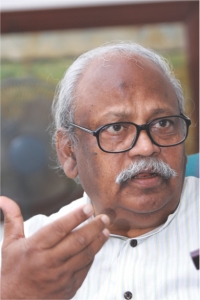| Home - Back Issues - The Team - Contact Us |
 |
| Volume 11 |Issue 25| June 22, 2012 | |
|
|
Event The World through Ranabi's Eyes Fayza Haq Bulban Osman, the Art History teacher, at the Faculty of Fine Art, University of Dhaka, for decades, was the first artist speaker on Rafiqun Nabi's newly launched travelogue 'Ranabi's Biswa Darshan Ramyakathan', before, the audience at Bengal Gallery, which was a sea of listeners spread in three large rooms. He said that the writer would jot down notes of the places he visited and people he met in the 22 countries in Europe, the United States, Africa, and Indian Subcontinent — and these notes ended up in the book published by Bengal Foundation.
Rafiqun Nabi spoke of the difficulty of learning Greek while he was in Greece, where he had been study. The Greek language remained bookish, at first, and sign language worked, when nothing else did, said the witty artist. It was wonderful that the writer could make fun of himself, and see the funny side of life, said Bulban Osman. The audience comprised of artists, writers and singers, at the Bengal Gallery on the weekend, Friday. Bulban Osman said that the figure of “Tokai” was important, as Nabi saw himself as some modern “David Copperfield”. Nabi's pictures were wrapped in fun, humor, rough –and- tumble and slapstick , like the writer Chakrabarty, whom Nabi, read as a child, and by whom he was naturally influenced. Nabi, Osman said, was also influenced by Abaninda Thakur, who had great influence in Rafiqun Nabi's life. Speaking to the audience, once more, Nabi spoke of how he and other young painters had gone to North Bengal. Coming away, they felt that they must bring some curd, along with them, to Dhaka from Bogra. Here, jesting, Nabi spoke of how he had upturned the container, and lost the “doi”. Thus his “boi” was full of observations like the upturned container of “doi”. Stating this fun –loaded episode brought more laughter from the evening's audience, of all ages. Qayyum Chowdhury spoke of the time when he was afraid that his eyes would fail in his middle year. This comic incident took place in Seoul, South Korea. Later, the artist realised that he had picked up his wife's glasses, by mistake. At this point, more laughter ensued from the gathered crowd, who had come to hear the senior artists, who had gathered for Nabi's book launching. He said that he hoped that more books would follow from Rafiqun Nabi, in the same manner—laced with humour and observations, which bring chuckles and guffaws. Syed Shamsul Haq, He spoke of the time when painter cum writers like Aminul Islam, would save on bookbinding in Kolkata-- during the early years of book binding. He commented that marketing a book is not easy, even today. He said he himself found writing and painting, like Aminul Islam, very difficult. Qamrul Islam, in his days, Shamsul Haque said, had different lines with different colours, to make things easy. Again, writers, like Murtaja Baseer, could write and paint at will. Baseer could steer up 300 words of fiction a day. The ability to paint and write, with ease, like Nabi, at one time, was a marvel, Haque said. Thus Nabi's “Tokai” was a national wealth, Syed Shamsul Haque added.
It is the beauty seen in things of common and everyday life, which writers like Nabi and Abdul Hye, dwelt on, said Shamsul Haque. Nabi had opened new avenues in Bengali classics, said Haque, who himself wrote on the beauty of nature everyday, and common faces he encountered. Thus he wrote his plays, said Shamsul Haque, from faces he came across everyday. It is from people Nabi met at Art Camps that he spun his stories of wit mixed with pain. He spoke of his book writing on Urdu Road libraries, munching “shingaras” and sipping tea, as he wrote. Nabi, an Ekushey Padak awardee, says the book focuses on events since 1972. It's a reflection on the Americans, Europeans and the Asians – different people whom he roamed around and met. He went with artists and art connoisseurs. The interactions of art and culture were important to note. Nabi says, that he wanted to build up something enjoyable, and side-splitting from the event that took place, during the visits to the different places. Nabi says that he does not wish to reach literary heights. The events are meant to be funny, but commonplace, nevertheless. He wanted a book that was readable and enjoyable. Political observations, information on what happened in other different countries are there. It is a collection of events, that took part in the various art camps. It is a collection of different experiences, focusing on other artists— taken from different countries. “The manner in which a writer or painter or film-maker sees things is not in the manner other people see things. Theirs is a world of their own. It is a part of their make up,” says Nabi. Was it not a fact that the father in Nabi's family was one of their finest source of inspiration for the children? “Because of his parents, the father could not indulge in fine arts. Yet he saw to it that his own children had the training of artists to reckon with—a world apart. Although a down to earth police officer, fine arts was in his blood. He wanted his children to depict life, nature and man within nature.” Nabi says that he does not fix himself in any single category. He doesn't wish to say that “This is my final work”, or “This is my final media”. Whatever he does, Nabi says that he tries to do it very sincerely. At times what he tries to do, says Nabi, is not the best. He feels, however, that he should give, each and every media a go.
|
||||||
Copyright
(R) thedailystar.net 2012 |

